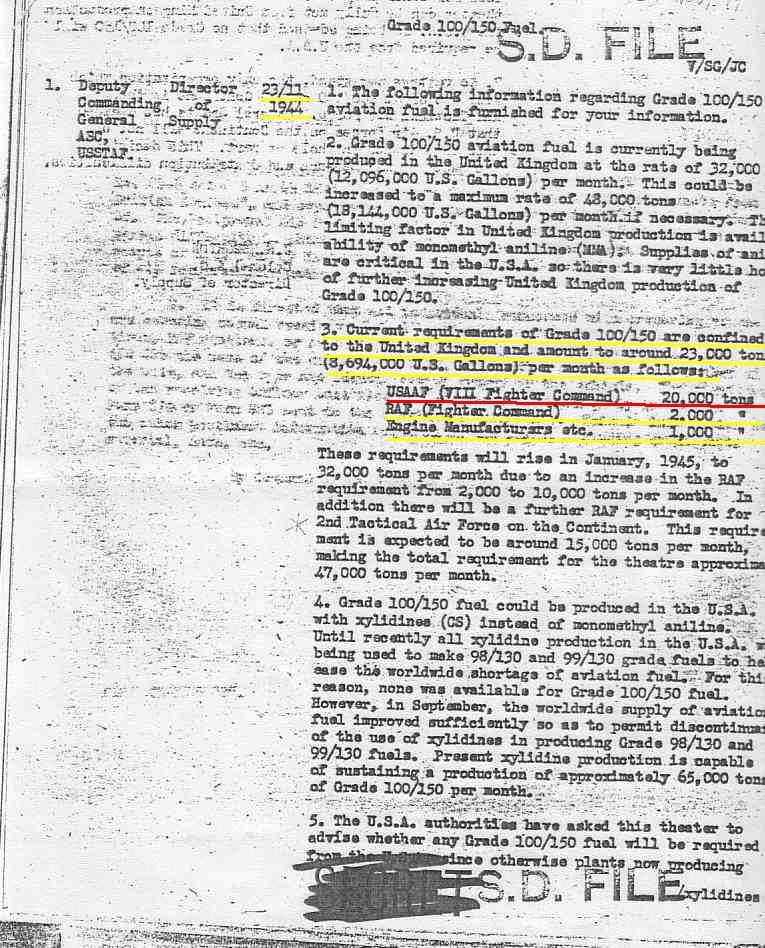Originally posted by Crumpp
The 9th AF argument does not hold water nor do any of the other smoke/mirrors posted. I said from the begining that having supply documents is not the same as operational documents. The 9th was under the North African fuel distribution district and not Europe.
Crumpp, you are the one using smoke and mirrors.
This clearly shows that the 8th AF monthly demand for 150 octane is expected to be in the range of 6-7.5 million IMP gallons (7.2-9 million US gallons) and that this was withing the supply capacity of UK production.
This document:

clearly shows that the monthly requirement of 150 octane is 20,000 tons (7.5 million US gallons) and states that this is within the supply capacity of UK production.
From
this link we can add up the 8th AF fighter sorties for Nov of 1944, and see that they flew 12,836 operational sorties for the month. At this point most of the 8th AF fighters were P-51s, which could carry a max of 489 US gallons (this total includes 2 110 gallon drop tanks). Now supposing for the sake of argument that they used every drop of gas on every operational sortie that month, that only totals 6.3 million US gallons used. Given that the fighters never used all of their gas (if they did, large numbers of them would have been failing to make it home), and often didn't even need to drop their tanks, this puts us well under the 7.5 million US gallon supply requirement of 150 octane with room to spare for training, local flights, maintenance, waste, etc.
The link you posted which is labeled "Gasoline consumption of airplanes with units in ETO" shows a consumption by fighters of 10.8 million US gallons. It makes no mention of fuel grade, or airforce. Simply that the units were "in ETO". Logically we would assume it is showing both 8th and 9th AF consumption given that the consumption total is FAR beyond the operational requirement of the 8th AF. Especially given that we have other documents that clearly state the 8th AF's supply and requirements for 150 octane fuel, and that those requirements much more closely match their actual useage based on operational sorties. This makes it clear that the 8th AF had enough supply of 150 octane fuel for all of their operational sorties.
(I also totaled the sorties for August 1944, just to give another random sample - 17,546 x 489 gallons = 8.6 million total, well below the 14.7 million on your chart for Aug 44 - and a large percentage of these missions were short range fighter bomber attacks in france which would have used much less fuel, and no drop tanks so 8th AF fighter consumption was almost certainly much lower then the 8.6mil I arrived at)
When we combine this with the fact that we also have docs showing that they tested the aircraft with the 150 octane fuel, found it worthwhile to use, delivered it to the stations (replacing the old 100/130), and used it, along with statements from pilots and ground crew describing using the fuel operationally, and photos of aircraft remarked for use with 150 octane fuel, it's an open and shut case in favor of Freeman's overview.
With regard to the actual performance of the fighters, the charts and reports on Neil's site clearly list the state of the aircraft. If you bother to read, a number of them are tested with wing racks installed. Clearly, there is a performance increase in both speed and RoC.